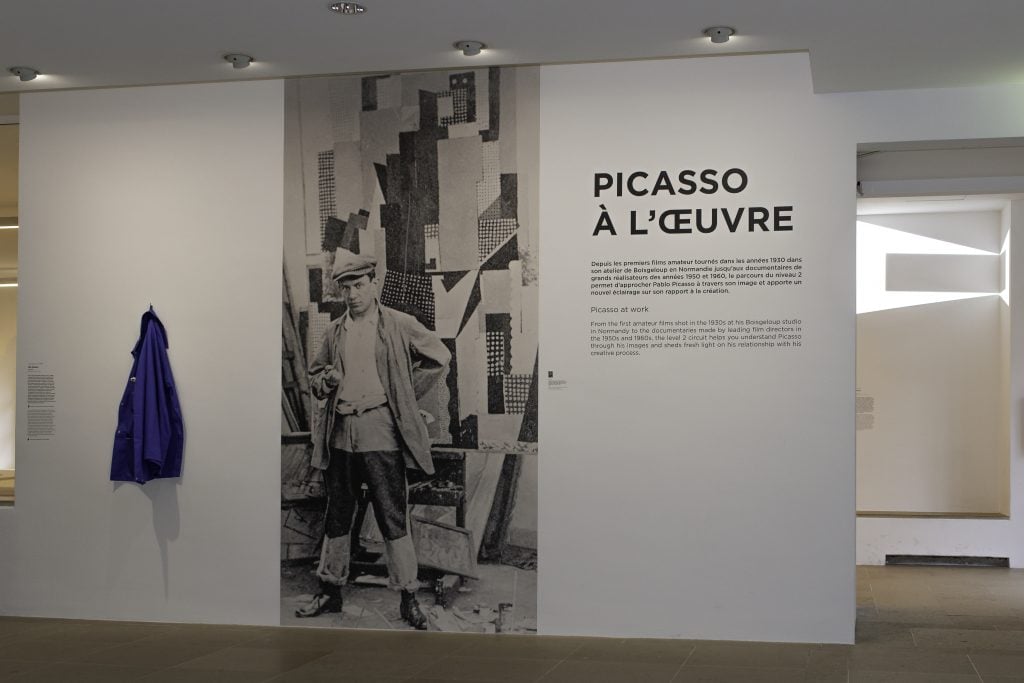Art World
A Senior Citizen Stole a Jacket Artwork on Display at the Musée Picasso and Then Had a Tailor Alter It to Fit Her
The culprit was caught when she went back to the museum.

The culprit was caught when she went back to the museum.

Anna Sansom

When Catalan artist Oriol Vilanova exhibited a jacket filled with postcards visitors could remove and examine at the Musée Picasso in Paris, little did he imagine that one person would take the liberty a step too far.
But in late March, a 72-year-old woman took the blue work jacket, which had been hanging on a wall, home with her. According to French daily Le Parisien, she then had it altered at the tailor’s so it would fit.
Upon returning to the museum to revisit the show a few days later, the woman—who had been captured on surveillance camera putting the jacket into her bag—was arrested by the police, who happened to be at the museum looking for evidence.
While in custody, the retiree—who was reportedly “passionate” about art, according to Le Parisien—immediately confessed to stealing the jacket but claimed not to have realized it was an artwork. Police searched her home, where they found it with shortened sleeves.
After a few hours of interrogation, the public prosecutor’s office let the woman off with a warning and dropped the case. According to Le Parisien, the woman had been placed under guardianship.
Vilanova’s artwork belongs to his “Old Masters” series (2017–21), which involved filling the pockets of a blue jacket with postcards depicting artworks by major figures in art history. At the Musée Picasso, the jacket was filled with postcards purchased at flea markets and museum shops, all with images of Picasso’s work. The jacket appeared next to a black-and-white photograph of Picasso in his studio and was presented in “Picasso à l’image” (through February 12, 2023), a thematic exhibition of the museum’s collection with archival photographs, films, and documentaries.

Artist Oriol Vilanova’s jacket artwork in the exhibition.
“When the museum told me the work had been stolen, I was surprised, but it was impossible to envisage the story that followed,” Vilanova told Artnet News.
But Vilanova disputes this. “I’ve always exhibited this artwork in the same way in other museums without any problem [as there were] security guards that guaranteed its safety,” he told Artnet News. “Other museums insured the artwork. If I had been aware of the risk of theft [at the Musée Picasso], I would never have exhibited it,” he said, adding that 150 postcards were also destroyed by the culprit.
The theft raises questions about the Musée Picasso’s security system. However, the museum told Artnet News it “proposed to the artist to secure [the jacket] on a coat-hanging system which would have prevented it from being unhooked off the wall.
“This option was not chosen by the artist because the public could not have manipulated the work easily. He wanted people to be able to handle not just the postcards, but the jacket too.”
Due to the nature of Vilanova’s piece, it was “not insurable for the risk of theft,” a point stated in its loan agreement with the artist, the museum said. “The artist was aware of the risk of the object being stolen.”
Based in Brussels, Vilanova describes his method of working as a “flea market studio practice.” His installations of chromatically ordered postcards, intended as a reflection on mass reproduction, have been exhibited internationally. Work from his “Old Masters” series had also been shown at the Albright Knox Art Gallery in Buffalo, as well as in Monaco and Belgium, where it was always free from harm.